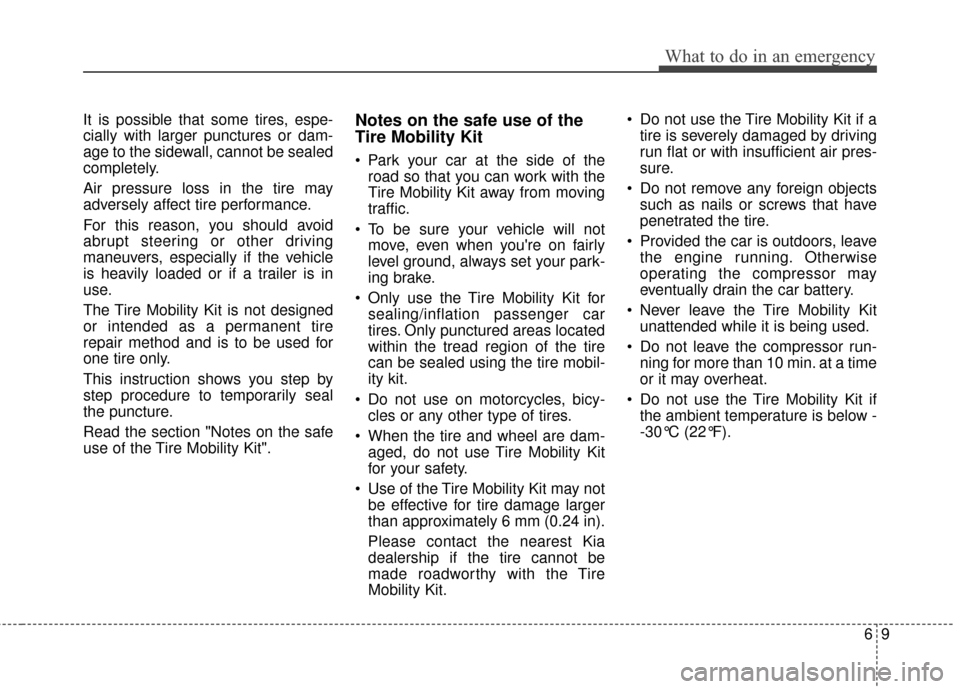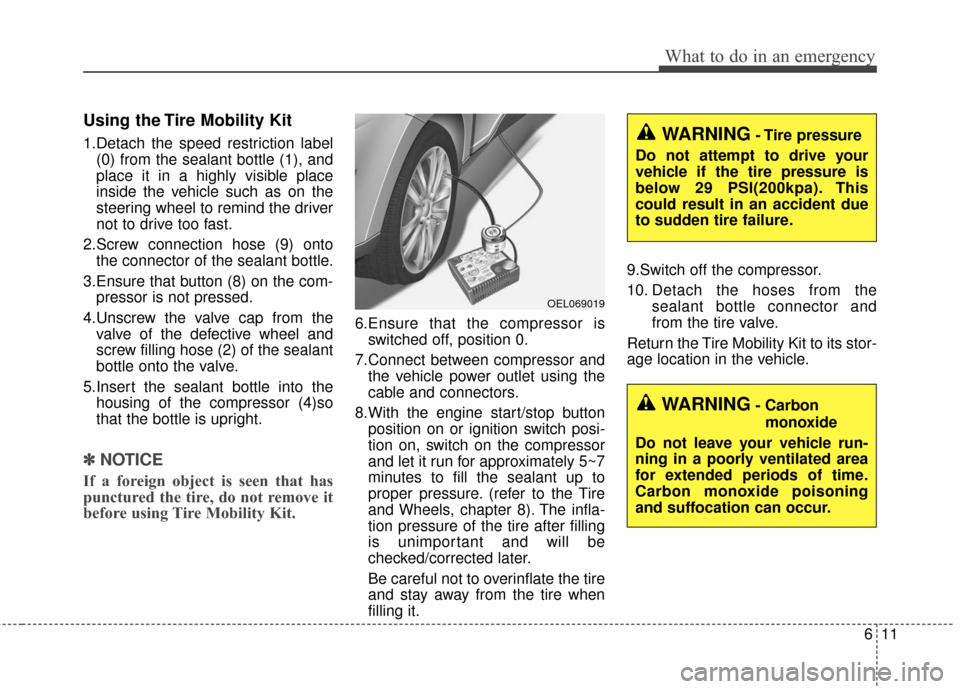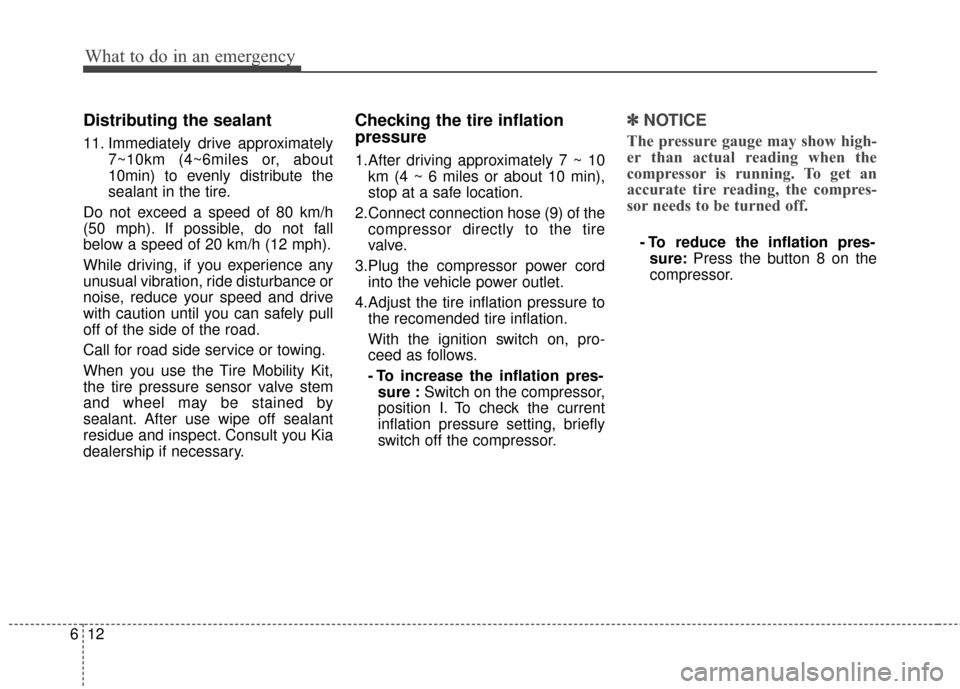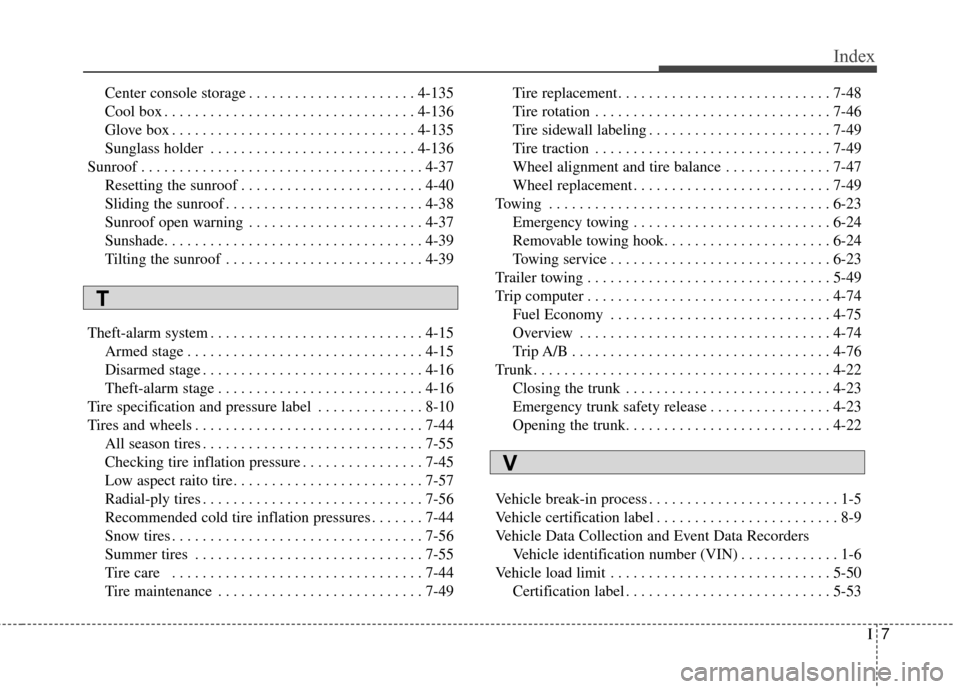run flat KIA Forte 2016 2.G Owner's Manual
[x] Cancel search | Manufacturer: KIA, Model Year: 2016, Model line: Forte, Model: KIA Forte 2016 2.GPages: 501, PDF Size: 14.8 MB
Page 386 of 501

69
What to do in an emergency
It is possible that some tires, espe-
cially with larger punctures or dam-
age to the sidewall, cannot be sealed
completely.
Air pressure loss in the tire may
adversely affect tire performance.
For this reason, you should avoid
abrupt steering or other driving
maneuvers, especially if the vehicle
is heavily loaded or if a trailer is in
use.
The Tire Mobility Kit is not designed
or intended as a permanent tire
repair method and is to be used for
one tire only.
This instruction shows you step by
step procedure to temporarily seal
the puncture.
Read the section "Notes on the safe
use of the Tire Mobility Kit".Notes on the safe use of the
Tire Mobility Kit
Park your car at the side of theroad so that you can work with the
Tire Mobility Kit away from moving
traffic.
To be sure your vehicle will not move, even when you're on fairly
level ground, always set your park-
ing brake.
Only use the Tire Mobility Kit for sealing/inflation passenger car
tires. Only punctured areas located
within the tread region of the tire
can be sealed using the tire mobil-
ity kit.
Do not use on motorcycles, bicy- cles or any other type of tires.
When the tire and wheel are dam- aged, do not use Tire Mobility Kit
for your safety.
Use of the Tire Mobility Kit may not be effective for tire damage larger
than approximately 6 mm (0.24 in).
Please contact the nearest Kia
dealership if the tire cannot be
made roadworthy with the Tire
Mobility Kit. Do not use the Tire Mobility Kit if a
tire is severely damaged by driving
run flat or with insufficient air pres-
sure.
Do not remove any foreign objects such as nails or screws that have
penetrated the tire.
Provided the car is outdoors, leave the engine running. Otherwise
operating the compressor may
eventually drain the car battery.
Never leave the Tire Mobility Kit unattended while it is being used.
Do not leave the compressor run- ning for more than 10 min. at a time
or it may overheat.
Do not use the Tire Mobility Kit if the ambient temperature is below -
-30°C (22°F).
Page 388 of 501

611
What to do in an emergency
Using the Tire Mobility Kit
1.Detach the speed restriction label(0) from the sealant bottle (1), and
place it in a highly visible place
inside the vehicle such as on the
steering wheel to remind the driver
not to drive too fast.
2.Screw connection hose (9) onto the connector of the sealant bottle.
3.Ensure that button (8) on the com- pressor is not pressed.
4.Unscrew the valve cap from the valve of the defective wheel and
screw filling hose (2) of the sealant
bottle onto the valve.
5.Insert the sealant bottle into the housing of the compressor (4)so
that the bottle is upright.
✽ ✽ NOTICE
If a foreign object is seen that has
punctured the tire, do not remove it
before using Tire Mobility Kit.
6.Ensure that the compressor is
switched off, position 0.
7.Connect between compressor and the vehicle power outlet using the
cable and connectors.
8.With the engine start/stop button position on or ignition switch posi-
tion on, switch on the compressor
and let it run for approximately 5~7
minutes to fill the sealant up to
proper pressure. (refer to the Tire
and Wheels, chapter 8). The infla-
tion pressure of the tire after filling
is unimportant and will be
checked/corrected later.
Be careful not to overinflate the tire
and stay away from the tire when
filling it. 9.Switch off the compressor.
10. Detach the hoses from the
sealant bottle connector and
from the tire valve.
Return the Tire Mobility Kit to its stor-
age location in the vehicle.
OEL069019
WARNING- Tire pressure
Do not attempt to drive your
vehicle if the tire pressure is
below 29 PSI(200kpa). This
could result in an accident due
to sudden tire failure.
WARNING- Carbon monoxide
Do not leave your vehicle run-
ning in a poorly ventilated area
for extended periods of time.
Carbon monoxide poisoning
and suffocation can occur.
Page 389 of 501

What to do in an emergency
12
6
Distributing the sealant
11. Immediately drive approximately
7~10km (4~6miles or, about
10min) to evenly distribute the
sealant in the tire.
Do not exceed a speed of 80 km/h
(50 mph). If possible, do not fall
below a speed of 20 km/h (12 mph).
While driving, if you experience any
unusual vibration, ride disturbance or
noise, reduce your speed and drive
with caution until you can safely pull
off of the side of the road.
Call for road side service or towing.
When you use the Tire Mobility Kit,
the tire pressure sensor valve stem
and wheel may be stained by
sealant. After use wipe off sealant
residue and inspect. Consult you Kia
dealership if necessary.
Checking the tire inflation
pressure
1.After driving approximately 7 ~ 10 km (4 ~ 6 miles or about 10 min),
stop at a safe location.
2.Connect connection hose (9) of the compressor directly to the tire
valve.
3.Plug the compressor power cord into the vehicle power outlet.
4.Adjust the tire inflation pressure to the recomended tire inflation.
With the ignition switch on, pro-
ceed as follows.
- To increase the inflation pres-sure : Switch on the compressor,
position I. To check the current
inflation pressure setting, briefly
switch off the compressor.
✽ ✽ NOTICE
The pressure gauge may show high-
er than actual reading when the
compressor is running. To get an
accurate tire reading, the compres-
sor needs to be turned off.
- To reduce the inflation pres-
sure: Press the button 8 on the
compressor.
Page 500 of 501

I7
Index
Center console storage . . . . . . . . . . . . . . . . . . . . . . 4-135
Cool box . . . . . . . . . . . . . . . . . . . . . . . . . . . . . . . . . 4-136
Glove box . . . . . . . . . . . . . . . . . . . . . . . . . . . . . . . . 4-135
Sunglass holder . . . . . . . . . . . . . . . . . . . . . . . . . . . 4-136
Sunroof . . . . . . . . . . . . . . . . . . . . . . . . . . . . . . . . . . . . \
. 4-37 Resetting the sunroof . . . . . . . . . . . . . . . . . . . . . . . . 4-40
Sliding the sunroof . . . . . . . . . . . . . . . . . . . . . . . . . . 4-38
Sunroof open warning . . . . . . . . . . . . . . . . . . . . . . . 4-37
Sunshade. . . . . . . . . . . . . . . . . . . . . . . . . . . . . . . . . . 4-39\
Tilting the sunroof . . . . . . . . . . . . . . . . . . . . . . . . . . 4-39
Theft-alarm system . . . . . . . . . . . . . . . . . . . . . . . . . . . . 4-15 Armed stage . . . . . . . . . . . . . . . . . . . . . . . . . . . . . . . 4-15
Disarmed stage . . . . . . . . . . . . . . . . . . . . . . . . . . . . . 4-16
Theft-alarm stage . . . . . . . . . . . . . . . . . . . . . . . . . . . 4-16
Tire specification and pressure label . . . . . . . . . . . . . . 8-10
Tires and wheels . . . . . . . . . . . . . . . . . . . . . . . . . . . . . . 7-44 All season tires . . . . . . . . . . . . . . . . . . . . . . . . . . . . . 7-55
Checking tire inflation pressure . . . . . . . . . . . . . . . . 7-45
Low aspect raito tire. . . . . . . . . . . . . . . . . . . . . . . . . 7-57
Radial-ply tires . . . . . . . . . . . . . . . . . . . . . . . . . . . . . 7-56
Recommended cold tire inflation pressures . . . . . . . 7-44
Snow tires . . . . . . . . . . . . . . . . . . . . . . . . . . . . . . . . . 7-56
Summer tires . . . . . . . . . . . . . . . . . . . . . . . . . . . . . . 7-55
Tire care . . . . . . . . . . . . . . . . . . . . . . . . . . . . . . . . . 7-44
Tire maintenance . . . . . . . . . . . . . . . . . . . . . . . . . . . 7-49 Tire replacement . . . . . . . . . . . . . . . . . . . . . . . . . . . . 7-48
Tire rotation . . . . . . . . . . . . . . . . . . . . . . . . . . . . . . . 7-46
Tire sidewall labeling . . . . . . . . . . . . . . . . . . . . . . . . 7-49
Tire traction . . . . . . . . . . . . . . . . . . . . . . . . . . . . . . . 7-49
Wheel alignment and tire balance . . . . . . . . . . . . . . 7-47
Wheel replacement . . . . . . . . . . . . . . . . . . . . . . . . . . 7-49
Towing . . . . . . . . . . . . . . . . . . . . . . . . . . . . . . . . . . . . \
. 6-23 Emergency towing . . . . . . . . . . . . . . . . . . . . . . . . . . 6-24
Removable towing hook. . . . . . . . . . . . . . . . . . . . . . 6-24
Towing service . . . . . . . . . . . . . . . . . . . . . . . . . . . . . 6-23
Trailer towing . . . . . . . . . . . . . . . . . . . . . . . . . . . . . . . . 5-49
Trip computer . . . . . . . . . . . . . . . . . . . . . . . . . . . . . . . . 4-74 Fuel Economy . . . . . . . . . . . . . . . . . . . . . . . . . . . . . 4-75
Overview . . . . . . . . . . . . . . . . . . . . . . . . . . . . . . . . . 4-74
Trip A/B . . . . . . . . . . . . . . . . . . . . . . . . . . . . . . . . . . 4-76\
Trunk . . . . . . . . . . . . . . . . . . . . . . . . . . . . . . . . . . . . \
. . . 4-22 Closing the trunk . . . . . . . . . . . . . . . . . . . . . . . . . . . 4-23
Emergency trunk safety release . . . . . . . . . . . . . . . . 4-23
Opening the trunk. . . . . . . . . . . . . . . . . . . . . . . . . . . 4-22
Vehicle break-in process . . . . . . . . . . . . . . . . . . . . . . . . . 1-5
Vehicle certification label . . . . . . . . . . . . . . . . . . . . . . . . 8-9
Vehicle Data Collection and Event Data Recorders Vehicle identification number (VIN) . . . . . . . . . . . . . 1-6
Vehicle load limit . . . . . . . . . . . . . . . . . . . . . . . . . . . . . 5-50 Certification label . . . . . . . . . . . . . . . . . . . . . . . . . . . 5-53
V
T